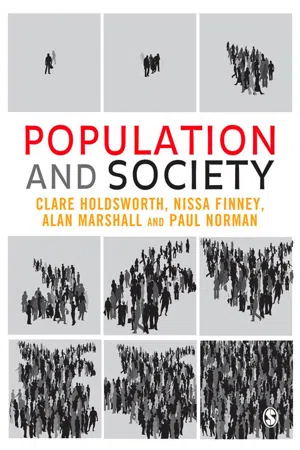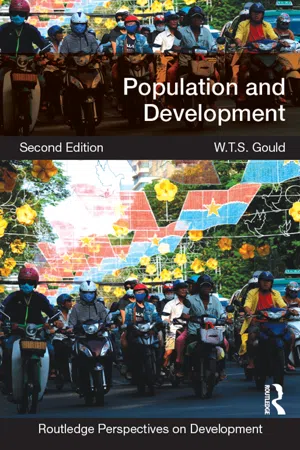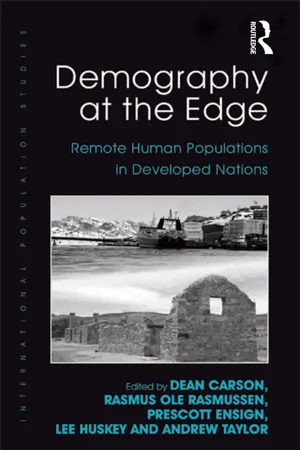Geography
Population Pyramid
A population pyramid is a graphical representation of a population's age and gender distribution. It consists of two bar graphs, one showing the percentage of males and females in different age groups. The shape of the pyramid provides insights into a population's demographic trends, such as birth rates, life expectancy, and overall population growth or decline.
Written by Perlego with AI-assistance
Related key terms
Related key terms
1 of 4
Related key terms
1 of 3
10 Key excerpts on "Population Pyramid"
- eBook - ePub
Britain's Population
Demographic Issues in Contemporary Society
- Steven Jackson(Author)
- 2013(Publication Date)
- Routledge(Publisher)
Figure 3.1 ). Quite apart from providing a neat and easily interpreted picture of population structure, pyramids can also give information about the recent history of population dynamics and about the varying experiences of different cohorts within the population. For example, the peaks in fertility in Britain in the late 1940s and mid-1960s can be traced on the contemporary pyramid as bulges in the age-groups 40–44 and 25–29.Figure 3.1 Age/sex structure (England and Wales) 1994Note: Percentage of total population in each five-year age categorySource : OPCS (1995), table 1Changes over the longer term can be analysed through the construction of pyramids for successive time periods. The impact of variations in the prevailing trends of fertility and mortality results in different overall shapes for the pyramids. Populations that experience high levels of fertility and mortality (especially infant and child mortality) develop pyramids with a wide base and a narrow apex. Mature populations, like Britain, with low levels of mortality, declining levels of fertility and a stable demographic regime, have pyramids which are more barrel-shaped; the majority of deaths are concentrated in the oldest age categories and the relative decline in births results in a narrowing of the base. It is also possible to identify likely trends in population change from the detailed shape of a pyramid, particularly the relative size of different age cohorts in the future. Figure 3.1 suggests that there will be a significant increase in the numbers reaching retirement age in Britain in the years 2021–5, for example.Population Pyramids are constructed with the age categories on a central vertical axis. Normally, one-year or five-year age categories are used and the final ages are collapsed into one category, e.g. 85 and above (for ageing populations this may include some misrepresentation of the actual distribution, as strictly speaking the figures should be spread over the remaining fifteen years or so of a possible life-span). Figures for males are recorded on the left of the diagram, with females on the right. The horizontal scale may either represent actual numbers (useful when representing changes in population size over time) or the percentage of the total population in each age category (useful for comparing differences in structure between populations of different sizes). The age categories may also be subdivided to show the component elements of a population as, for example, in Figure 3.2 - eBook - ePub
Population Geography
Social Justice for a Sustainable World
- Helen D. Hazen, Heike C. Alberts, Kazimierz J. Zaniewski(Authors)
- 2023(Publication Date)
- Routledge(Publisher)
Jones 2013 ). Many children also spend much of their family life in the company of adults, particularly the increasing number of only children in affluent societies, with both positive and negative implications for social development. Non-traditional family arrangements are also becoming increasingly common in many countries, including single-headed households, same-sex parents, and blended families, providing a diversity of experiences for children. Though there is nothing inherently problematic with any of these arrangements, they raise different challenges and benefits compared with the extended families that were common until recently.One of the key tools used to explore age structure is the Population Pyramid . A Population Pyramid uses two mirroring bar graphs to show the age and sex structure of a population (figure 3.9 ). By convention, the male population is shown on the left and females on the right. The vertical axis of the pyramid represents age cohorts —groups of people born during the same time period (often 5-year groups)—with the youngest group at the bottom and the oldest at the top. The shape of a Population Pyramid quickly reveals information about the age structure of the population. Pyramids that are wide at the bottom and narrow at the top (roughly triangular) represent societies characterized by high fertility and rapid population growth but many children dying before reaching adulthood. Population Pyramids for more affluent countries are more column-like, with fewer children being born and therefore a narrow base to the pyramid but most people surviving into old age. Long life expectancies mean that even elderly cohorts may still comprise large numbers of people. In the oldest age groups, we expect more females than males, owing to women’s slightly longer life expectancies.FIGURE 3.9Population Pyramids for economically less and more developed regions, 2015–20Data source: UNDESA (2019) .At smaller scales, Population Pyramids can reveal very specific information about a population’s age and sex structure. For instance, figure 3.10 shows two US counties—one heavily influenced by college students and the other representing a retirement community. Population Pyramids can also reveal unique features about the history of a country: a baby boom will appear as a widening of the pyramid, whereas a war may be seen as an indentation in the male side of the pyramid. Over time, bulges and indentations work their way up the pyramid as cohorts age. We may also see an “echo” of a bulge or indentation in the next generation as a particularly large (or small) cohort reaches its childbearing years and goes on to have an unusually large (or small) number of children. For example, in 2021 it was reported that the number of 18-year-olds was rising sharply in the UK as the result of an “echo of an echo” from a baby boom in the mid-1950s (The Economist - eBook - ePub
- Andrew Hinde(Author)
- 2014(Publication Date)
- Routledge(Publisher)
Figure 13.2 ). Pyramids drawn using percentages are useful for comparing age and sex distributions, provided that the horizontal and vertical scales used in all the pyramids are the same.THE DEPENDENCY RATIOThis is a frequently used summary measure of the age and sex structure. It is defined as the ratio of economically inactive to economically active persons. In other words, it measures the number of inactive people whom each economically active person has to support.Since the economically inactive are mainly the young and the old, in practice the dependency ratio is calculated by dividing the total number of people under age a 1 and over age a 2 by the number of people between ages a 1 and a 2 Usually, a 1 is taken to be an age close to the school-leaving age, and a 2 an age close to the retirement age. In the United Kingdom, for example, a 1 = 16 years and a 2 = 60 or 65 years. The availability of data may determine the exact ages to be used in a particular population. In addition, it is possible to take a 2 to be different for males and females, if statutory retirement ages differ by sex.Figure 13.2 Population Pyramids for Uganda (1991) and Sweden (1995). Sources: United Nations (1995b, pp. 190–191); Statistics Sweden (1997, p. 40)An alternative measure of dependency is the proportion of the total population which is of working age (that is, aged between a 1 and a 2 ). This measure uses the same information as the dependency ratio, but is easier to understand.13.3 The demographic determinants of the shape of the Population Pyramid
Fertility and mortality both affect the shape of the Population Pyramid. Their effects are rather different from one another, however. FERTILITYThis has the most important effect in theory, and also often in practice. Its largely determines the width of the base of the Population Pyramid. High-fertility populations have pyramids which, when drawn using percentages, are wide at the base and narrow at the top (see the example of Uganda in Figure 13.2 ). Low-fertility populations tend to have a smaller percentage of children, and a correspondingly higher percentage of old people (see the example of Sweden in Figure 13.2 - eBook - ePub
- Clare Holdsworth, Nissa Finney, Alan Marshall, Paul Norman(Authors)
- 2013(Publication Date)
- SAGE Publications Ltd(Publisher)
Hinde (1998) usefully points out that the age-sex structure of an area is influenced by demographic events in the past so that a pyramid is effectively a historical record of past population. Hinde (1998: 163–4) provides a detailed interpretation of the age-sex structure of France in 1992. Figure 4.2 Dependency ratios: national populations, 2005 Source: UN Population Division (2009b) World Population Prospects. The 2008 Revision The population at any time point is a function of the previous population plus births which have occurred and minus deaths. Also, the population size and structure will be affected by migration in and out of an area. In Figure 4.3 a, a Population Pyramid of the UK population in 2001 is annotated for several features. Those aged 0–4 in the population (a) will have been born within the previous five years whereas those aged 85 or over (b) were born before 1916. At ages over 70 there is an increasing predominance of females due to their longer life expectancy. Any of these people may have been born in this area and aged in situ or have moved from elsewhere. Note that the smaller the geographical area, the more likely it is that migration will have affected population structure and the greater the size of the impact. Previous rises and falls in fertility, and the number of live births, are evident. In Figure 4.3 a, those aged 50–54 (c) were born in the period following the Second World War when troops were returning home. From the late 1950s into the 1960s there was a ‘baby boom’. In 2001 these persons were in their thirties and forties (d) and are represented by the swell in the bars at these ages. Following the baby boom, there was a ‘baby bust’ when fertility rates fell rapidly and remained low during the 1970s accounting for the pinch in the pyramid (e). The slight increase around the 10–14 age-group (f) is a ‘baby boom echo’ as the relatively large baby boom generation had children themselves - eBook - ePub
- W.T.S. Gould(Author)
- 2015(Publication Date)
- Routledge(Publisher)
6 , changes have occurred at different speeds and at different times in the various regions of the world, triggered by different processes of fertility, mortality and migration, and with a variable mix between them. For most of the longer periods of human history most populations have experienced a relatively low growth, and fertility and mortality being roughly equal at high rates, with fertility at roughly five children per woman and life expectancy at birth somewhere in the thirties, but with relatively little local in- or out-migration. High fertility and mortality regimes dominated by childhood deaths created populations characterised by a large number of young people relative to older people and a distinctively pyramidal age/sex structure. However, as populations have changed as part of the process of development, partly driven by development, partly as a response to development, the characteristic shape of the age/sex pyramid has been changing. It has become more variable from country to country and within any one country at any one time. Where fertility falls, there will be fewer people than previously in the youngest age groups; where medical advances mean greater survival of adults as well as children then there will be more older people; where there is age-specific labour migration, migration source regions will lose some of their middle-age group, but destination areas, as a direct consequence, will have populations with a higher than average proportion of people in these age groups.Figure 7.1 illustrates some of these patterns in the classic age/sex diagrams that summarise and compare the population structures at national level of four countries in the Middle East (Roudi-Fahimi and Kent 2007). Yemen has the pyramid shape that is typical of populations with high fertility but also high mortality, a high equilibrium population with high fertility, just at the beginning of the early expanding phase of the DTM. For Iran there is evidence of substantial fertility decline in the last 20 years, with successive age cohort groups being smaller than the previous cohort (that is, 20–24 is smaller than 25–29 years, 15–19 is smaller than 20–24, until the youngest cohort is slightly larger than the 5–9 cohort). A few African countries that have experienced similar substantial fertility declines in recent years (for example, Botswana, Zimbabwe and Kenya) display such age structures (Tabutin and Schoumaker 2004, 2005). Egypt is more typical of those countries that have experienced major improvements in adult mortality, in Developing Countries generally, but most particularly in those countries of East Asia and Latin America that have progressed substantially through the demographic transition. Qatar, in sharp contrast, describes one of the exceptional and distinctive cases of the oil-rich Gulf States of the Middle East, where substantial in-migration of temporary labourers, mostly male, has been needed to meet the labour market needs of a rapidly expanding economy. Thus, the age/sex pyramid provides not only a snapshot of the age/sex structure of the population at any given time, but it can also reveal within it key features of the demographic history of a country or region over a lifetime (see Box 7.1 for a general discussion of age data and the idea of ‘age dependency’, and Box 7.2 - eBook - ePub
Ageing, Lifestyles and Economic Crises
The New People of the Mediterranean
- Thierry Blöss(Author)
- 2017(Publication Date)
- Routledge(Publisher)
The important changes which have occurred in the structure of the population can easily be appreciated by looking at Figure 1.4, which compares the age and sex distributions of the resident populations in 1951 and in 2014. The Population Pyramid consists of a back-to-back bar graph: each bar represents the proportion of the population of a certain age and sex in the total population. By convention, males are plotted on the left side of the x-axis and women on the right. The changes in population structure over time are evident. The age pyramid for 2014 has an obviously narrower base (due to low fertility) and wider top (due to growth in the relative proportion of the elderly) than that of 1951. The life expectancy gender gap makes the relative weight of females aged 65 years or more considerably higher than that calculated for males. Moreover, it should be noted that the mean age of the resident population has increased considerably over the past 60 years: it was 29 in 1951 and 44 in 2014. Figure 1.4 Population Pyramid: Italy. 1951–2014 Sources: Istat, Census data (1951) and population register (2014) http://demo.istat.it Numerous measures for population structure by age can be calculated. Here we present the figures for the ageing index, calculated as the number of persons aged 65 or over (conventionally considered to be the elderly population) per hundred persons under the age of 15 (the young population). Figure 1.5 shows the trend in the ageing calculated for the period 1951–2014. In 1951, the young population definitely outnumbered the elderly in Italy: the ageing index in that year was 31, meaning that for every 100 young people there were 31 aged 65 or more. A small gender gap can be seen: the higher female life expectancy resulted in a higher ageing index for resident women (35.1) than for men (27.7) - eBook - ePub
An Introduction to Population Geographies
Lives Across Space
- Holly R. Barcus, Keith Halfacree(Authors)
- 2017(Publication Date)
- Routledge(Publisher)
There is a clear prima facie case for the discipline of Demography : “the scientific study of the size, composition, and distribution of human populations and their changes resulting from fertility, mortality, and migration” (Poston and Bouvier 2010: 3). Births, deaths and human migrations between locations across the globe certainly require measurement, presentation and discussion, and future trends predicted. But whilst Demography also involves itself with the causes of the patterns, trends and magnitudes it identifies—“the factors that affect these components” (Poston and Bouvier 2010: 3)—a more dedicated emphasis on their contextualized spatial expression has become the focus of Population Geography. 1.2.2 … across real places Population Geography can be defined initially as the study of “the geographical organization of population and how and why this matters to society” (Bailey 2005: 1). An immediate illustration of how such a spatial lens is both significant and important comes, once again, via some simple demographic facts about the state of the world today (developed more fully in Chapter 3). Consider infant mortality rates (10.3.1) in a small selection of countries in Asia and Europe, shown in Table 1.1. First, even across these ten countries there is a considerable range of values. This is true even within the same continent, such as the contrast between Romania and Norway in Europe. Second, although there is a general trend towards declining infant mortality, countries such as Mongolia and India retain extremely high rates. Furthermore, many countries affected by civil strife, such as Afghanistan, Congo or Iraq, are understandably unable to provide data. Thus, Table 1.1 is biased in favor of countries experiencing relative political stability - eBook - ePub
Demography at the Edge
Remote Human Populations in Developed Nations
- Rasmus Ole Rasmussen, Prescott Ensign, Lee Huskey, Dean Carson, Dean Carson(Authors)
- 2016(Publication Date)
- Routledge(Publisher)
Chapter 2 ). Missing data about a relatively small number of people will have large effects on the shape of age pyramids. As with all studies of remote populations, therefore, age data is difficult to interpret ‘from a distance’ unless the researcher knows about data issues and can hypothesise about the events leading to specific bubbles and craters. Demography, history and local knowledge are inextricably linked in the case examples presented in this chapter.Demographic transition theories describe a change in the shape of age pyramids over time from those resembling triangles to those resembling ‘coffin’ or ‘cigar’ shapes – a much more even distribution of the population across ages (Banks 2008). The even distribution sees median ages rise as there are proportionally fewer children and proportionally more older people. It is the progression of working-age people (either 15–64 years or 20–64 years depending on who is doing the measuring) into older age groups that has been a focus of literature examining the ‘ageing crisis’ in developed nations. The ‘crisis’ is the increased expense of health care and other services required by older people coupled with the loss of productivity resulting from reduced proportion of people in the labour force (Jackson 2006). Not all analysts agree that ageing of this type inevitably presents an economic ‘crisis’ (Werblow et al. 2007), however the implications for the health care system (irrespective of how the system is funded) are generally agreed.The progression of substantial proportions of people into post working-age groups has been a topic of concern in remote Australia (Larson 2006) and Europe’s northern sparsely populated areas (Manthorpe and Livsey 2009) and the subject of extensive planning in Alaska (Alaska Department of Health and Social Services 2007a, 2007b). Emma Lundholm and Dieter Müller’s case example in this chapter revisits the situation in the European North, noting that age-differentiated migration patterns (young people are more likely to leave than old people) are one of the key underlying factors in that context. A crater appears in the working age group, with over-representation of the very young and of the old. They also note the influence of amenity in-migration in some regions. Much of the amenity migration into these regions is by post working-age people who are ‘multi-residential’ – they have homes in more than one location. In many cases, the bubbles created by amenity migrants are hidden in formal data collections (see Chapter 2 - eBook - ePub
Demographics
A Guide to Methods and Data Sources for Media, Business, and Government
- Steven H. Murdock, Chris Kelley, Jeffrey L. Jordan, Beverly Pecotte, Alvin Luedke(Authors)
- 2015(Publication Date)
- Routledge(Publisher)
Chapter 2 Basic Concepts, Definitions, and Geography of Demography As with any area of study, it is essential in demography to understand its basic concepts and the definitions of its key terms and to become familiar with the types of geographic areas for which demographic data are generally available. Knowing the jargon of demography and knowing the types of areas for which data can be obtained are essential first steps in knowing how to effectively use its data. In this chapter, we provide an overview of key concepts and definitions and examine the geographic bases used in demography and its applications. Basic Dimensions and Processes Given the definition of demography as the study of population size, distribution, and composition and of the processes that determine these, a logical place to begin in understanding demographic factors is to understand (1) what is meant by a population; (2) the three key dimensions of population–size, distribution, and composition; and (3) the three basic processes that determine population change–fertility, mortality, and migration. A population refers to the persons living in a specific area at a specific point in time. It refers to the aggregate, the group of people as a whole, in an area. As such, it has characteristics that are unique to an aggregate and are not just the sum of individuals’ traits or characteristics. For example, a population can have a death rate, birth rate, etc., but individuals are either alive or dead, have or have not been born. There is no death or birth “rate” for an individual - Guo Zhigang, Wang Feng, Cai Yong(Authors)
- 2017(Publication Date)
- Routledge(Publisher)
Not only were the bipolar bulges present in the age pyramid, they also led to a higher ratio of total dependency compared to the urban population. The absolute number of dependents, elderly or junior, was also much higher than that in urban areas. The urban-rural Population Pyramid in Figure 9.7 illustrates several conclusions: first, the distribution of young laborers in China has more weight in cities and towns; second, more than half of the women of childbearing age in China already reside in a city or town; third, the burden of the rural elderly is heavier, in both population size and dependency ratio, compared to the urban burden. These have important implications for national economic and population renewals. Another important implication we can draw from Figure 9.7 is the relative change in the population size of children compared to that of the working-age. Children are the reserves for the two renewals of production and reproduction, and the relative changes in scale can reveal future prospects. As shown in Figure 9.7, in the current rural residents, the juvenile age groups had slightly smaller, yet comparable populations to the working-age groups. However, the current situation in rural areas is post out-migration of large numbers of laborers. The comparable number of the juvenile population is itself suggestive of an unsustainable future of continuous out-migration of laborers, since the system of supporting the elderly in rural areas would collapse. On the other hand, the pronounced concavity in urban juvenile groups suggests a great need for future in-migration of laborers to maintain normal socioeconomic development
Index pages curate the most relevant extracts from our library of academic textbooks. They’ve been created using an in-house natural language model (NLM), each adding context and meaning to key research topics.
Explore more topic indexes
Explore more topic indexes
1 of 6
Explore more topic indexes
1 of 4









